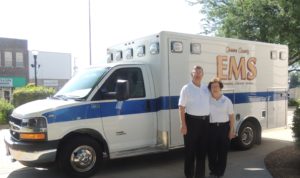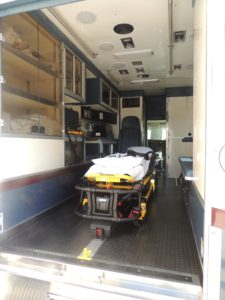
Dennis and Marcia Morlan on July 1 marked the 30th anniversary of taking the helm at Greene County Emergency Medical Services by picking up a new ambulance in Rock Rapids. Just as his contract started on the first day of a new fiscal year 30 years ago, the funding became available July 1 for the new ambulance. Morlan went with a check in his hand for the balance due on the rig.

The Morlans are understandably proud of the new ambulance, a Horton box mounted on a Chevy chassis. It is larger than any of their older ambulances with a 158-inch wheel base. It resembles a small hospital room with space for six or seven EMTs and the patient. It carries a vast array of equipment and drugs, as well as the new 12-lead electrocardiogram machine recently purchased with a $25,000 grant from the American Heart Association. It is equipped for the new Stryker cot the Morlans personally funded. The mechanical cot takes most of the lifting out of loading or unloading a patient.
“She’s going to be a pretty girl,” Morlan told the county supervisors in May after a trip to see the new ambulance while it was being assembled. He was correct.
Over the course of 30 years, Greene County EMS has grown from two van-style ambulances to three box-style ambulances. An older fourth ambulance now belongs to the Churdan rescue squad and is available if needed. The number of calls has grown from 294 in their first year to 825 in the fiscal year just ended.
What hasn’t grown is the contract with the county. The county owns the ambulances and budgets $50,000 a year for EMS. Of that, $3,200 per month goes toward salaries (not just for the Morlans, but for all the GCEMS crew) and the remaining $11,600 per year goes toward utilities and things like tires and batteries for the ambulances.
GCEMS owns the equipment in the ambulances, a cost Morlan estimates at between $30,000 and $50,000 per unit. He estimates the cost of insurance at another $50,000 a year.
The majority of GCEMS funding comes from user fees. Marcia Morlan handles all the insurance billing, as well as being part of the EMT crew.
Dennis Morlan realistically describes the ambulance business as part of the transportation industry, with the greater part of their calls being transfers from one facility to another and rather routine calls. “The number of actual life-threatening emergencies we have is very few. It’s not blood, guts and vehicle accidents. Some of our calls are intense, but most aren’t ‘back to the wall’,” he said.
Still, “you never know what you’re going to get into. That’s what makes the job so interesting.”
The ambulance service is the most visible part of Morlan’s work, but it’s not what gives him the greatest sense of accomplishment. He is proud to know that Greene County is a safer place because of his work, citing the 9-1-1 rural addressing system, the storm warning siren system, and emergency planning as examples.
He was appointed as the county’s emergency management director very soon after taking over GCEMS. That job, which paid $10,000 when he started and now pays $12,000 annually, led to other tasks.
Although the groundwork started being laid for 9-1-1 nationally in the late 1950s, it wasn’t until the 1990s that a rural address system, necessary for successful 9-1-1 response, was mandated in Iowa. A 9-1-1 board was formed in the county and Morlan was appointed chairman.
At that time, rural addresses were given as routes and box numbers and there was no way to identify easily the location of some rural properties. Morlan and Doug Hawn, who was a sheriff’s deputy at the time, collaborated on the system now in use, with north-south roads named in alphabetical order from west to east, and east-west roads numbered from north to south.
At the same time, infrastructure work was done so that all 9-1-1 calls would go directly to the law enforcement center in Jefferson, bypassing the local phone exchanges.
“I view that as a tremendous benefit to public safety,” Morlan said.
The storm warning siren system is a job that Morlan calls “a job done right.” “I’m so pleased with the system. It’s superior to all,” he said.
After the city of Jefferson replaced its antiquated siren system, the 9-1-1 board funded new sirens for the remaining county towns. The sirens all interface with a computer at the LEC, and every day at 2 am the computer sends a message to each siren to be sure it’s working.
The sirens can be activated in each town or from the LEC. The LEC’s entire communication system is backed up (hardware and software) at the GCEMS office across the street from Morlan’s home, and the EMS office is hooked to Greene County Medical Center’s emergency generator. “Most counties don’t have that kind of back-up,” Morlan said.
His job as emergency management director is hopefully a job of planning rather than implementing. “The things we worry about are natural events – blizzards, tornadoes, wind storms, ice storms, flash floods – not terrorists,” Morlan said. “We like to think we’ve planned for all eventualities.”
He plays an important role when disaster decrees are needed to make state and/or federal funds available for clean-up after an event like the Memorial Day flooding in Scranton two years ago.
Morlan is also a founder of Region 5 HAZMAT Commission’s local emergency planning committee (LEPC). That group was formed after the federal government mandated HAZMAT planning in the late 1980s. “The mandate was too much for small counties to take on alone, so we formed a LEPC with six other counties and based it in Fort Dodge because that’s the only city in those counties with a fulltime fire department,” he said.
“The ethanol plant (Louis Dreyfus LLC in Grand Junction) is safe, but there’s a three-mile evacuation zone around it, and that calls for planning. We have a railroad and Highway 30 going across the county, so we need to plan what to do if there’s a problem with hazardous loads there.
“It’s ‘knock on wood’ planning that we do. We want to never use the plans, but we sleep better knowing that if something happens, we know what to do,” he said.
A power failure a couple years ago in Churdan was a time plans were used. The power outage jeopardized the city water plant, but water service wasn’t interrupted because there were plans ready to be put in place, Morlan said.
The number of agencies involved in emergency planning leads to between 300 and 500 emails a week in Morlan’s inbox. That alone would keep many people busy, but Morlan works his way through all of them.
Morlan became a medical examiner investigator in the same way he has taken on other responsibilities. “A lot of things happen by accident. I see a need and I fill it,” he said.
A fatal accident during a blizzard that prevented a doctor from arriving to pronounce the victim deceased prompted Morlan to complete the St Louis University medical examiner course in 1996 so he could serve as the county’s medical examiner investigator. A doctor must sign a death certificate, but a MEI can make the death pronouncement.
He now does almost all the ME investigations in the county, about 16 per year. He has done 290 death investigations over the years. Some take 2-4 hours, while others can take up to 50 hours. “That’s people who have died in their sleep, accidents, some murders, pediatric deaths, suicides…. I’m seen so much over the years I can’t take any type of violence or drama on television,” he said.
He named a four-fatality accident in November of 2001 as an event that stands out as one of the worst calls of his career. Two vehicles collided on Highway 30 between Jefferson and Scranton – one was an eastbound van of football fans going to the Iowa-Iowa State football game, which had been rescheduled because of the 9-11 terrorist attacks, and the other was a westbound car with two high school students racing back home after a long night of partying in Ames. Both teens and two passengers in the van were killed.
“That was the worst. It affected so many people,” he said. Morlan is also trained to do critical incident stress debriefing. When asked how he handles that stress himself, he answered, “Thank God I’ve got Mrs. M.” She added, “Thank God we’ve got each other.”
He is also part of the Iowa Department of Public Health’s Iowa Mortuary Response Team (IMORT). The 40-person team includes physicians, dentists and medical examiner investigators and would respond to a major incident that resulted in a high number of fatalities.
Morlan has also delivered at least four babies. He easily recalls a birth in a dining room, two in cars, and one in the back of an ambulance.
Thirty years heading Greene County EMS is a long tenure, but it isn’t Morlan’s first work. He graduated from Jefferson High School in 1962 and went to the University of Northern Iowa to pursue a degree in business administration. He took a job in a movie theatre in Cedar Falls, falling back on his job experience during high school at the Iowa Theatre in Jefferson.
That led to theatre management jobs and finally to a job with Central States Theatres in Hasting, NE. It was in Hastings that he took his first EMT class in 1980 (or so)and was in the first paramedic class at Kearney State College in 1983. He went to work for Adams County Ambulance in Nebraska and took the courses needed to teach emergency medical services at Central Community College. He has continued to teach EMT classes and has trained hundreds of EMTs over the years.
Marcia Morlan was managing a shoe store in Hastings when she also took an EMT class.
It was a conversation between Dennis’s mother and Frank Tucker, who was a county supervisor at the time, that led to the Morlans’ return to Jefferson in 1986. Between Dennis and Marcia they had done thousands of ambulance calls, and they had the business management experience needed to make the business work.
Dennis Morlan said that as a UNI student he also thought seriously attending Culver-Stockton College in Canton, MO, to become a pastor in the Disciples of Christ. That path would have led him to a caring profession, as did the path he ultimately took.
At age 72, Morlan has no plans to retire. “I’m blessed with quality health, and I have friends who have retired and ended up hating it,” he said. He and Marcia kid each other about purchasing an $8 million home for sale in Savannah, GA – a city they love and visit as often as they can – should they win the lottery, but there are no plans for either of them to retire soon.
Dennis is very worried about the future of emergency medical services in the county. “There are serious issues there. The younger generation isn’t stepping up. It’s a nationwide problem,” he said.
Years ago the Grand Junction rescue squad had 20 to 30 trained EMTs; it now has only four. The Churdan rescue squad has only four EMTs, and the Scranton squad has no EMTs. Greene County EMS covers the entire county, sending an ambulance for back-up when the Grand Junction squad rolls.
He has offered many courses with online options for part of the coursework to make it easier for busy people to schedule it. Still, the numbers dwindle.
In the meantime, Morlan says, “The work keeps me young. I have a purpose. I contribute, and I feel a sense of accomplishment.”
When the Morlans eventually do retire, there will be a very large seat and deep tire tracks to fill.
